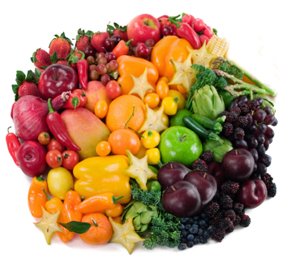Why we should all be vegetarians
Current mood: disgusted
Although I am not a vegetarian myself, it is now something that I am SERIOUSLY considering. After watching the video "Meet your meat" on www.chooseveg.com, I was not only disgusted but I was angry, hurt, and disappointed in us as humans. There is nothing wrong with the consumption of meat, but to torture, injure, mutilate, scald, abuse, and purposely injure these animals while still alive is completely unacceptable. Watch this video (http://www.chooseveg.com/animal-cruelty.asp) and then tell me that you don't feel what I feel.
Want turkey for Thanksgiving?? Are you sure? (http://www.chooseveg.com/turkey-slaughterhouse.asp)
Not even wild animals, that we often refer to as beasts, are as cruel as us humans are. Is this how we use our "power" while at the top of the food chain? Animal cruelty has been deemed a felony in many states but yet when it comes to the commercial breeding and slaugther in modern intensive production farms, all of a sudden the rules do not apply.What's the difference between a cow and a dog? They both feel pain in the same way, so just because we don't get our kids calfs and chickens for their birthdays, doesn't mean we get to hurt them that way.
Don't get me wrong...I LOVE meat. Yes, i LOVE meat. I can not promise that I'll never eat meat again, but I do promise to try my hardest to buy meat substitutes whenever possible, and cut out meat all together whenever I can.
On Compassion Towards Animals
Posted: 19 Jan 2009 01:51 AM PST
The question is not, “Can they reason?” nor, “Can they talk?” but rather, “Can they suffer?” - Jeremy Bentham
Post written by Leo Babauta. Follow me on Twitter.
I’m guessing many of you won’t be interested in this post, or may actually be annoyed by it, but given that I’ve written a number of times before about Compassion, I felt the need to talk about compassion towards animals.
When we talk about compassion, it’s usually towards other human beings — family, friends, neighbors, co-workers, strangers, people out there in the world, suffering. We talk about empathizing and understanding their suffering, and wanting to act to ease or end the suffering. We talk about taking action, through kindness, to end the suffering in some way.
But there are some who believe in compassion towards all living things, including me.
Many of us have pets now or have had pets in the past, and we can completely understand compassion towards animals. You wouldn’t want to hurt your beloved pet, would you? Extend that empathy, compassion and kindness to all other animals, including animals raised and killed for food, clothing, or other such uses.
Most people don’t make this connection, because food is seen as food, not a living, feeling creature who might suffer. Most of us are very removed from this suffering in modern life, as a whole series of steps have to be taken to get the meat (or other product) from the living animal to our plates: raising and slaughtering the animal is done in another part of the world, then the meat is processed, packaged, packed, shipped, chopped, cooked, served, and what have you, depending on the food.
If we could see first-hand the conditions that these animals live in, how they’re treated, what they’re fed and shot up with, we might feel differently. It’s not just the killing of an animal that causes suffering (although often it’s done in very inhumane ways), but their living conditions from birth to death.
Animals in our society are treated as non-living, non-feeling objects, and yet they aren’t. They suffer, just as we do.
Anyway, I won’t go on and on about this … I just wanted to bring it up as a subject for consideration, thought, discussion. I know many of you will disagree, or scoff, but at any rate I think it’s a worthy topic, for anyone who cares about compassion.
“The greatness of a nation and its moral progress can be judged by the way its animals are treated.” - Gandhi
Some links for further reading:
People for the Ethical Treatment of Animals (PETA)
Animal Compassion Network
Compassion in World Farming
Teach children to be kind to animals
How to Become a Vegetarian the Easy Way
“The animals of the world exist for their own reasons. They were not made for humans any more than black people were made for white, or women created for men.” - Alice Walker
Cancer-Fighting Foods
By Natasha Persaud
January 2009
Brightly colored and delicious, fruits and vegetables can help protect you from some cancers—in addition to their other health benefits. “Many phytonutrients are contained in the pigments of the plant,” explains Stephanie Meyers, R.D., a licensed nutritionist at the Dana-Farber Cancer Institute in Boston. “The deeper and richer the pigment, the higher the level of these nutrients. Phytonutrients help protect the plant from disease, but research suggests they may also confer health benefits on people.”
According to the World Cancer Research Fund, the strongest evidence shows that non-starchy vegetables and fruits probably protect against cancers of the mouth, larynx, pharynx, esophagus, lung and stomach. Research is ongoing to determine the mechanisms; the combination of nutrients each fruit or vegetable supplies may be vital.
“Load up your plate with as many colorful plant-based foods as you can. Eating a plant-based diet all year long is the best way to help lower your risk of cancer, not to mention other illnesses,” says Meyers. To eat your way to health, choose brightly colored produce from each of these five color groups: red, yellow-orange, green, blue-purple and white. Some fruits and veggies may fall under more than one color group. We list those that have shown the most cancer-fighting potential.
Red
What to eat: Cranberries, strawberries, raspberries, red apples, cherries, tomatoes, pink grapefruit, radishes, red peppers and beets.
What red may do: Cranberries contain the cancer-fighting nutrient benzoic acid, among other phytonutrients, which lab studies suggest can inhibit the growth of lung cancer, colon cancer, and some forms of leukemia.
Berries, particularly strawberries and raspberries, are rich in ellagic acid, a substance that has been shown in laboratory studies to prevent cancers of the skin, breast, bladder, lung and esophagus.
Apples, particularly the skin, contain quercetin; early research suggests that this nutrient helps protect your cells’ DNA from damage that could lead to the development of cancer. Daily consumption of apples and other foods containing quercetin has been associated with lower incidence of lung cancer.
Tomatoes, watermelons, pink grapefruits and pink guavas contain lycopene, which may offer some protection against prostate and stomach cancer.
Serving suggestions
Add dried cranberries to your salad; make cranberry sauce, relish or dressing
Toss fresh berries in your morning yogurt, oatmeal or cereal.
Make a smoothie by blending fresh or frozen berries with six ounces of juice.
The lycopene in tomatoes is best absorbed when tomatoes (whether fresh, canned or jarred) are crushed and cooked with oil , so cook up tomatoes for pasta sauce; a soup or stew base; or a sauce for seafood, poultry, meat, rice or even sandwiches.
Toss bite-size apple pieces, with the skin on, into salads and rices; sauté apple wedges with chicken or turkey breast; make baked apples.
Sample Recipe
Cider Baked Apples
Yellow-Orange
What to eat: pumpkin, carrots, sweet potatoes, papaya, cantaloupe, pineapple, summer and winter squash, apricots, nectarines, peaches, oranges.
What yellow-orange may do:
Yellow and orange-colored fruits and vegetables contain carotenoids (such as beta-carotene), plant chemicals that have been linked to the prevention of cancers of the colon, prostate, breast, lung, mouth and esophagus.
Serving suggestions
Carotenoids are best absorbed with some fat, so chop, puree and cook these vegetables with a small amount of a healthy oil, such as olive oil; or consume them as part of a complete meal.
Choose “sweet” or “pie” pumpkins for cooking, roasting or baking. Make pumpkin soup or bread.
Cut up fresh pineapple for pineapple chicken or tropical fruit salad. You can also make relish or homemade jam with no sugar added.
Add chopped carrots to salads, soups and stews. Add shredded carrots to slaw.
Simmer squash in stew or bake whole squash.
Make fruit salsa or salad with peaches, nectarines and apricots; or use these fruits in hot relishes to lend a hint of sweetness. Note: It’s best to keep the skin on.
Toss orange segments in green salads or Asian-inspired dishes, such as orange chicken.
Sample Recipe
Butternut Squash & Carrot Soup
Green
What to eat: Cruciferous vegetables, such as broccoli, cabbage, Brussels sprouts and bok choy; dark leafy greens, such as spinach, kale, collard greens, mustard greens and turnip greens.
What green may do: Research on cruciferous vegetables highlights several plant nutrients that have been linked to lower cancer risk, among them the compounds known as glucosinolates. Preliminary research suggests that consumption of these vegetables raises the levels of certain enzymes that defend the body from cancer-causing agents.
Cruciferous and dark leafy green vegetables contain glutathione transferase, an enzyme that helps the body get rid of toxins that may contribute to cancer. Greens also contain large amounts of chlorophyll, which some research suggests interferes with the absorption of potential carcinogens from meat or smoke.
Serving suggestions
To maximize the nutrient benefits of cruciferous vegetables, vary between eating them raw and quick-cooking them by sauteing, blanching or steaming.
Sauté greens with olive oil and garlic, or steam them in a basket or steamer that sits above the water to prevent nutrients from leaching into the water and evaporating.
Cut up cruciferous veggies into crudités and serve with a bit of low-fat dip.
Steam or blanch leafy greens or vegetables, toss with garlic and herbs, and serve as a side dish instead of potatoes.
Sample Recipe
Winter Squash and Kale Risotto With Pine Nuts
Blue-Purple
What to eat: Blueberries, raspberries, blackberries, pomegranates, currants, boysenberries, dried plums, raisins, purple grapes and eggplant.
What blue and purple may do: Anthocyanins and a number of other plant chemicals in blueberries, blackberries, raspberries, pomegranates and other produce have been shown to attack precancerous cells, stem the proliferation of cancer cells and induce cancer cell death in laboratory studies. Research is continuing to see if they may have a beneficial effect in people.
In addition, grapes and some berries contain the potent antioxidant resveratrol, which preliminary research suggests may help prevent the kind of cell damage that promotes cancer.
Serving suggestions
Toss berries and raisins into muesli, yogurt, oatmeal, cereal and granola.
Add them whole to breads.
Snack on grapes.
Stuff eggplant with currants, almonds and rice.
Add eggplant to vegetable bakes, stir fries, pastas and lasagna.
Sample Recipes
Mixed Berry Sundaes With Yogurt & Pomegranate Juice
Grilled Eggplant & Bell Peppers
White
What to eat: Plants in the Allium family—onions, garlic, shallots, scallions and leeks.
What white may do: High intakes of plants in the allium family contain sulfur compounds that may help protect against gastric and colorectal cancer. Research is ongoing about other potential benefits of these foods to prevent cancer.
Serving Suggestions
The protective effect of garlic against DNA damage can be best enhanced by crushing or mincing garlic and allowing it to stand for 15 to 20 minutes prior to cooking.
Most savory dishes—whether they’re made with vegetables, seafood, poultry or meat—taste better with garlic and onions, so add a good amount to whatever you prepare. Be sure to mince or crush garlic before cooking to maximize anti-cancer potency.
Add leeks to soups, vegetable stir-fry dishes, casseroles and dips.
Shallots add mild onion and garlic flavor to sauce, soups and dips.
Used liberally in Asian cuisine, scallions add a wonderful mild onion flavor to any dish.
Sample Recipe
Broccoli Rabe With Garlic and Parmesan
A Cancer-Protective Diet
Along with eating a variety of fruits and vegetables, choose whole grains, legumes (such as beans, peas and lentils), omega-3 rich foods (such as fatty fish) and lean protein sources (including fish, poultry and lean meat). Also consider adding the spice turmeric to your diet. In early trials, curcumin, a compound in turmeric that gives it a yellow color, has demonstrated some ability to fight colorectal cancer.
Limit red meat to 11 ounces or less a week. Some research suggests an excess of red meats in your diet can contribute to colon cancer. Also, limit your alcohol consumption to no more than two drinks a day for men and one drink a day for women.
A Note on Supplements….
While it may be tempting to simply pop a vitamin, such as beta-carotene, for your supply of nutrients, research has not shown dietary supplements to be effective in fighting cancer.
Eat Your Fruits & Veggies
Aim for at least five servings a day; one serving is the equivalent of a medium piece of fruit, one cup of raw fruits or veggies, or a half cup cooked fruits and veggies.
Eat the whole fruit, including the skin (when edible), since research shows that many of produce’s health benefits are contained in the skin.
Choose among fresh, dried or frozen fruits and veggies. Limit canned varieties because they may contain preservatives and excess salt or sugar. The phytonutrient content of produce is highest right after it’s picked.
Eat a mixture of raw and cooked fruits and veggies to get the most nutritional impact.
Wash all raw fruits and vegetables, even if the packaging says “pre-washed.”
Steam, roast or sauté your veggies using minimal water or oil for the shortest period of time to retain nutrients. Avoid overcooking.
While juices have some cancer-fighting properties, they’re less potent than what you get when you eat the whole fruit or vegetable, and they often contain added sugar. Limit yourself to one serving (six ounces) of juice a day.
Fruit baked in pies, while delicious, is not particularly healthy because of the added sugar and fat. Opt for fruit salad topped with plain yogurt instead.
Friday, January 16, 2009
Subscribe to:
Post Comments (Atom)























































































































































































































































.jpg)








































































































































































































































































































































































































































































































































































































































No comments:
Post a Comment